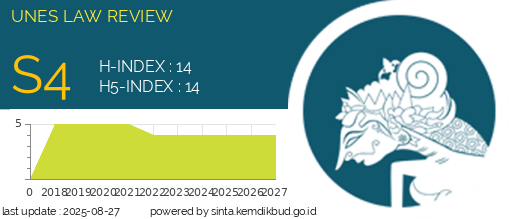Implementasi Restorative Justice pada Tindak Pidana Narkotika yang dilakukan oleh Anak
DOI:
https://doi.org/10.31933/unesrev.v6i1.872Keywords:
Narcotics Abuse, Children, Restorative Justice DiversionAbstract
The development of an increasingly advanced era has positive and negative impacts on one's environment to grow and develop negatively or positively. Of course, with this development there are negative things that cannot be separated from human social life. A good environment will produce a person's personality to be good, and vice versa if the environment is negative then the person will become negative. A negative environment can lead a person to commit crimes such as narcotics abuse, starting with adults or children. However, currently children can commit criminal acts of drug abuse based on a bad environment. The results of the discussion in this study reveal that a child who falls into drug abuse is the impact of a bad environment, such as a lack of supervision from the family, lack of education, and a bad environment for a child to grow and develop. So that the role of parents is very important in protecting and educating children to avoid drug abuse so there is no need to deal with the law. In addition, the role of the state and government is very important to tackle drug abuse by children, so that a child can still get their rights by providing fair legal considerations and decisions through restorative justice diversion to children.
Downloads
References
Bynum, J. E. (2002). Juvenile Delinquency a Social Approach. Boston: Allyn and Bacon A Peason Education Company.
Gultom, M. (2012). Perlindungan Hukum Terhadap Anak dan Perempuan. Bandung: Reflika Aditama.
Hadisuprapto. (2003). Pemberian Malu Reintegratif Sebagai Sarana Non Penal Penanggulangan Perilaku Delinkuensi Anak (Studi Kasus Semarang dan Surakarta). Universitas Diponegoro.
Hawari, D. (1997). Al-Qur’an, ilmu Kedokteran Jiwa. Yogyakarta: PT. Dana Bakti Primayasa.
Herlina. (2004). Perlindungan Terhadap Anak Yang Berhadapan Dengan Hukum; Manual Pelatihan Untuk Polisi. Jakarta: POLRI & UNICEF.
Imran, N. F. (2020). Penegakan Hukum Terhadap Tindak PidanaPenyalahgunaan Narkotika Yang Dilakukan Oleh Anak. Indonesia Journal of Criminal Law, 97.
Kristian. (2017). Sistem Peradilan Pidana Terpadu dan Sistem Penegakan Hukum Di Indonesia. Jakarta: Prenada Media Group.
Nadeak, W. (1978). Korban Ganja dan Masalah Narkotika. Bandung: Indonesia Publishing House.
Nyoman Krisna Yudha, A. A. (n.d.). Perlindungan Hukum Terhadap Anak Sebagai Pelaku Tindak Pidana Narkotika. 7.
Ohchr.org. (1989). Convention on The Rights of The. Retrieved from https://www.ohchr.org/Documents/ProfessionalInterest/crc.pdf
Purnianti, S. M. (2003). Analisa Sistem Peradilan Pidana Anak (Juvenvile Justice System). Jakarta: UNICEF Indonesia.
Siswantoro, S. (2004). Penegakan Hukum Psikotropika. Jakarta: Rajawali Pers.
Soedjono. (1985). Narkotika dan Remaja. Bandung: Alumni.
Sudarto. (2010). Kapita Selekta Hukum Pidana. Bandung: Alumni.
Sukihana, F. P. (2013). Pidana Dan Tindakan Terhadap Tindak Pidana Narkotika Yang Dilakukan Oleh Anak. Kertha Wicara.
Wahyudi, S. S. (2009). Pengembangan Diversi Dalam SistemPeradilan Pidana Anak sebagai Perlindungan dan Upaya Menghindari Pengaruh Buruk Proses Peradilan Terhadap Anak. Kertha Wicaksana, 23.
Downloads
Published
How to Cite
Issue
Section
License
Hak cipta :
Penulis yang mempublikasikan manuskripnya di jurnal ini menyetujui ketentuan berikut:
- Hak cipta pada setiap artikel adalah milik penulis.
- Penulis mengakui bahwa UNES Law Review berhak menjadi yang pertama menerbitkan dengan lisensi Creative Commons Attribution 4.0 International (Attribution 4.0 International CC BY 4.0) .
- Penulis dapat mengirimkan artikel secara terpisah, mengatur distribusi non-eksklusif manuskrip yang telah diterbitkan dalam jurnal ini ke versi lain (misalnya, dikirim ke repositori institusi penulis, publikasi ke dalam buku, dll.), dengan mengakui bahwa manuskrip telah diterbitkan pertama kali di Jurnal UNES Law Review.



















